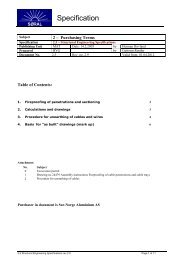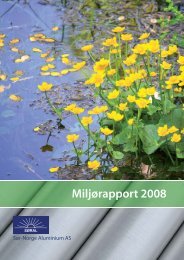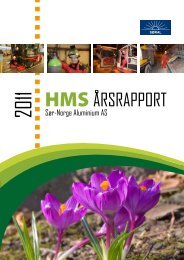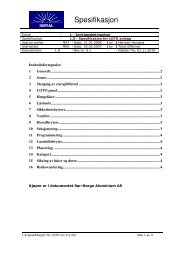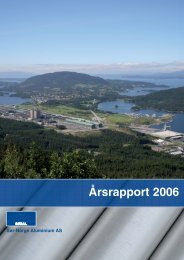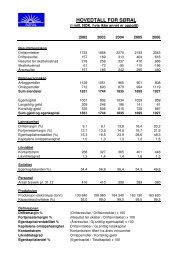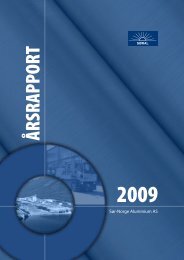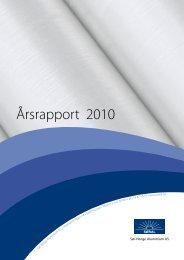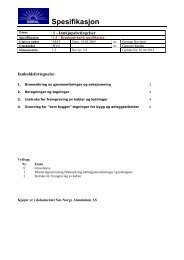Spesification - Sør-Norge Aluminium AS
Spesification - Sør-Norge Aluminium AS
Spesification - Sør-Norge Aluminium AS
You also want an ePaper? Increase the reach of your titles
YUMPU automatically turns print PDFs into web optimized ePapers that Google loves.
<strong>Spesification</strong><br />
Topic<br />
1 – Terms of Purchase<br />
Specification 2.3 – Electro Technical Specification<br />
Publisher Unit MAT Date: 19.08.1997 Herman Hovland<br />
Created By TEK Torstein Fykse<br />
Document No. : 2.3 Revision No. 8.1 Valid From: 20.04.2007<br />
Table of Contents:<br />
1. GENERAL INFORMATION ABOUT PURCH<strong>AS</strong>ER’S ELECTRICAL INSTALLATION .....2<br />
2. NORWEGIAN REGULATIONS, DIRECTIVES, AND PARTICULAR REQUIREMENTS..3<br />
3. WORKMANSHIP REQUIREMENTS .................................................................5<br />
4. REQUIREMENTS FOR DOCUMENTATION AND TRAINING ............................... 13<br />
5. PURCH<strong>AS</strong>ER’S STANDARD (MATERIAL LIST) ............................................... 16<br />
Attachments:<br />
No. Topic<br />
1 Low Voltage Supply System Drawing No. 18908<br />
2 Detailed Description of Drawing No. 18908<br />
3 Arrangement Drawing No. 27123 page 401.<br />
4 Arrangement Drawing No. 27123 page 404.<br />
5 Main Electrical Diagram Drawing No. 27121 page 17.<br />
6 Control Current Diagram Drawing No. 27121 page 30.<br />
7 Control Current Diagram Drawing No. 27121 page 31.<br />
8 PLC Inputs Drawing No. 27121 page 81.<br />
9 PLC Outputs Drawing No. 27121 page 189.<br />
10 PLC 24v DC Supply for PLC In/Outputs. Drawing No. 37747-7 page 5.<br />
11 Fire Proofing Drawing No. 24479<br />
Purchaser in this document is Sør-<strong>Norge</strong> <strong>Aluminium</strong> <strong>AS</strong>.<br />
2.3 Electro technical specification rev 8.1 Side 1 av 35
<strong>Spesification</strong><br />
1. GENERAL INFORMATION ABOUT PURCH<strong>AS</strong>ER’S ELECTRICAL INSTALLATION<br />
1.1 High Voltage Installation<br />
300kV.<br />
The Main Supply for SØRAL has a voltage of 300kV which is supplied from the central power<br />
grid.<br />
The central power grid consists of two lines from Blåfalli Switching Station and a subsea cable<br />
from Stord.<br />
24kV.<br />
The unregulated supply has a voltage of 24kV. This supplies the rectifier and the regulating<br />
transformers. The output to SKL/KE is also connected here. The neutral point is insulated.<br />
Maximum I k is 31.5kA.<br />
Phase Compensating<br />
2 ea. capacitor batteries of 65MVAr are connected to 24kV unregulated distributions.<br />
The capacitor batteries are switched in through 2 steps. When connecting, powerful switching<br />
transients occur, in particular at the 400V level.<br />
20kV.<br />
The general plant supply has a voltage of 20kV, which normally is supplied from one of two<br />
30MVA regulating transformers. The neutral point is insulated.<br />
The purchaser’s transformer stations are supplied with regular 20kV via ring cables from the plant<br />
supply in 20kV buildings.<br />
The Maximum I k for 20kV in the transformer station is 12kA.<br />
Short circuit yield can be stated for each item on request from the purchaser’s electrical<br />
department.<br />
1.2 Low Voltage Installations<br />
There are low voltage switchboards in the transformer stations which are supplied from<br />
distribution transformers with a ratio of 20/0.400 kV or 20/0.690kV.<br />
In general, 400V is used as distribution system (TNCS-System) for motors and other 3-phase<br />
loads. 220v direct connection between Phase and N is used for lighting (see attachment 1 and 2).<br />
As an exception, 690v is used for larger motors and heating installations.<br />
Control voltage (usually 220v AC) is supplied by a control power transformer (secondary side).<br />
The control power transformer (primary side) is connected to 400v (between two phases).<br />
Ground fault monitoring shall be installed on the 220v side when using control power<br />
transformers. For PLC installations, etc., a ground fault alarm shall be presented via the control<br />
system. For smaller installations, a signal lamp indicating ground faults can be installed in the<br />
cabinet door.<br />
For local fault message/alarm, the following system is used:<br />
1. Fault present: Blinking red light, possibly also an acoustic alarm.<br />
2. Alarm deactivated: Continuous red light.<br />
3. Fault removed : Light off<br />
2.3 Electro technical specification rev 8.1 Side 2 av 35
<strong>Spesification</strong><br />
For some installations, transferring some or common alarms to the gate guard is also desirable.<br />
This can be done in the current system or agreed separately.<br />
The purchaser’s rectifier installation for electrolysis produces some overharmonic oscillations<br />
back to the power grid.<br />
Short circuit performance at the secondary side of the distribution transformer is in the range of<br />
30kA. This can be stated separately for each point on request from the purchaser’s electrical<br />
department.<br />
2. NORWEGIAN REGULATIONS, DIRECTIVES, AND PARTICULAR REQUIREMENTS<br />
2.1 General.<br />
All assembly and installation shall be performed in accordance with current publications from<br />
DSB:<br />
Regulation on safety at work on and operating electrical installations, with instructions. (FSE)<br />
Regulation on Electrical Low Voltage Installations, with instructions.<br />
Regulations on Electrical Supply Installations. (FEF)<br />
Regulations on qualifications for electrical professionals, with instructions. (FKE)<br />
Before the work commences, the supplier shall send a message to the purchaser’s expert manager<br />
of operations.<br />
After delivery, the installation shall be CE-marked in accordance with current directives.<br />
- Machine Directive<br />
- Low Voltage Directive<br />
- EMC Directive<br />
Plants and products shall be delivered with either the manufacturer declaration or conformity<br />
declaration. The necessary verification documents shall be delivered with the conformity<br />
declaration. Ref. NEK 400-6.<br />
Unless other written agreements have been made, all material shall be delivered in accordance<br />
with the purchaser’s standard (item 5).<br />
If the work has been performed in conflict with current regulations or the purchaser’s<br />
specifications, the error must be corrected unless it has been agreed otherwise. The Supplier shall<br />
cover all costs in connection with correcting such errors.<br />
2.2 FIRE PROOFING OF CABLE PENETRATIONS AND SECTIONING<br />
2.2.1 Approved fire proofing materials shall be used for fire proofing.<br />
Furthermore, when nothing else is prescribed, the proofing shall be of the same fire class as the<br />
part of the building where the proofing is being done.<br />
2.2.2 Cable Routing.<br />
Cable trays/bridges shall be completed in front of the penetration to insure good proofing and<br />
access. Drawing No. 24479, attachment 10, show penetrations in fire classes A60 and A120<br />
respectively, and also fire sectioning with painting of cables horizontally, vertically, and<br />
diagonally.<br />
2.2.3 Penetrations for piping and ventilation.<br />
The supplier will clarify how penetrations will be proofed.<br />
Joint foam or building foam must not be used.<br />
2.3 Electro technical specification rev 8.1 Side 3 av 35
<strong>Spesification</strong><br />
2.2.4 Marking.<br />
The places where the proofing is done shall be clearly marked in accordance with instructions<br />
from the officer in charge.<br />
These shall be marked with information about the fire proofing company and the date of the fire<br />
proofing.<br />
2.3 Paint work, Corrosion Protection, etc.<br />
2.3.1 This shall be performed in accordance with the description of surface treatment of steel and<br />
aluminum constructions.<br />
2.3.1.1 Objective.<br />
The norm has been set to obtain a consistent and correct treatment in terms of quality of the<br />
surfaces of aluminum and steel constructions. The implemented systems will cover various<br />
environments and usage areas and any deviations from the norm shall be agreed separately.<br />
2.3.1.2 General.<br />
The purchaser will, when necessary, specify the painting system in their request. The products of<br />
the specified manufacturers shall be used unless otherwise described or agreed in writing<br />
beforehand.<br />
2.3.1.3 Standards.<br />
Pre treatment - ISO 8501-1<br />
Chemical purity - ISO 8502-1 to 4<br />
Surface texture - ISO 8503-1 Ry 2 – 3<br />
Adhesion test - ISO 4624<br />
2.3.1.4 Deviations.<br />
Deviations from the norm must be approved in writing from the purchaser.<br />
2.3.1.5 Source.<br />
This description is, for the most part, worked out in accordance with Norsk Hydro’s norm EH-015,<br />
and the Purchaser’s Building Technical Specification Part 1.5, paint work and specifications.<br />
2.3.1.6 Abbreviations.<br />
PUR - Polyurethane<br />
ISO - International Standardizing Organization<br />
TFT - Dry Film Thickness indicated in µm. (micron)<br />
YL - Air quality and supply in the work environment<br />
RAL - International color code specification no. 1.5, paragraph 1.<br />
2.3 Electro technical specification rev 8.1 Side 4 av 35
<strong>Spesification</strong><br />
3. WORKMANSHIP REQUIREMENTS<br />
3.1 HIGH VOLTAGE.<br />
3.1.1 Contactor Cabinet, Control Cabinet, Measuring Fields, etc.<br />
Description in item 3.2.1. with under items shall be followed unless otherwise agreed.<br />
3.1.2 High Voltage Equipment<br />
3.1.2.1 Bus Bars<br />
At delivery of bus bar installations, these shall be adapted to existing grounding systems, and<br />
delivered with appropriate grounding appliances.<br />
Ue to the high current in the rail systems, the nuts and bolts on the rails shall be made from<br />
stainless steel.<br />
3.1.2.2 High voltage cabinets / Power Switches / Knife Disconnectors.<br />
Compact cabinets or cabinets for switch trolleys may be used in transformer stations. Short circuit<br />
current for the cabinet shall be minimum I k =12.5kA. The switches shall be rated I n =630A.<br />
In the main power supply installation (24kV), cabinets for switches mounted on switch trolleys<br />
with short circuit current of minimum I k =31.5kA, and switches for 2500A are required.<br />
In 20kV buildings, switches for regulated 20kV distributions (20kV) shall have minimum short<br />
circuit current of I k =12.5kA and I n =1250A, or as agreed otherwise.<br />
The purchaser is planning on using SF6 power switches.<br />
3.1.2.3 High Voltage Cables.<br />
All high voltage cables shall be rated at 24kV or as agreed otherwise.<br />
3.1.2.4 End Termination.<br />
Here it may be differentiated between indoor and outdoor types, depending on where the<br />
installation is mounted. Conventional end terminations and terminations of a ”touch proof” type<br />
can be used indoors.<br />
3.1.2.5 Transformers.<br />
To be produced and delivered in accordance with IEC 60076-1 and IEC 60076-2.<br />
All distribution transformers shall have oil insulation, preferably with silicone oil. Data sheet for<br />
the transformer oil shall be referenced in all offers to the purchaser.<br />
Accessories shall be agreed for each case. Such accessories shall monitor oil temperature, gas<br />
pressure and oil level.<br />
All transformers shall be delivered with swiveling wheels.<br />
The temperature indicator on the transformer shall be readable from the inspection point. All<br />
transformers shall be mounted with signs indicating all substantial transformer performances,<br />
volume and weights. All signs and indicators shall be readable when the transformer is in<br />
operation, without endangering the personnel.<br />
For distribution transformers that do not have standard performance, and power transformers rated<br />
at over 1600kVA, a special agreement is required.<br />
2.3 Electro technical specification rev 8.1 Side 5 av 35
<strong>Spesification</strong><br />
Short circuit performance at the secondary side of the distribution transformer is in the range of<br />
30kA. This can be stated separately for each point on request from the purchaser’s electrical<br />
department. Connection points for grounding devices shall be installed in transformer cells.<br />
3.1.3 Installation and Mounting of High Voltage Supply Installations.<br />
Installation plan and test plan shall be presented for the purchaser in a reasonable time before the<br />
installation commences.<br />
3.1.3.1 Bus Bars.<br />
The torque shall be documented for all screw connections. The standard being used shall be<br />
documented. On the plant, every connection shall be “checked off”.<br />
If specified, documented resistance measurements shall be performed for bus bar deliveries in<br />
addition to insulation measurements. Place mounted bars and pre fabricated, insulated bus bars<br />
shall be tested with 50kV for one minute.<br />
3.1.3.2 High voltage cabinets / Power Switches / Knife Disconnectors.<br />
Simplified user manual in Norwegian for switches and guards shall be presented before the<br />
installation is powered up.<br />
For all high voltage areas, there shall be signs mounted which show manufacturer, year of<br />
production, performance, voltage and short circuit currents. A short user instruction shall also be<br />
placed on the front of installed devices. All text shall be in Norwegian.<br />
3.1.3.3 Cable Laying, High Voltage Cables<br />
High voltage cables must be attached with approved cable fasteners and the laying shall be<br />
documented.<br />
Calculations regarding short circuit power and dimensioning of fastenings shall be presented to<br />
SØRAL.<br />
When feasible, the high voltage cables shall be routed on separate cable trays/paths. In case high<br />
voltage cables are routed on the same cable tray as low voltage cables, the purchaser shall be<br />
contacted, and the distance between the cable paths shall be made in accordance with regulations.<br />
3.1.3.4 Termination and Connection<br />
Crimping of cable lugs/connection sleeves on aluminum cables shall be applied with ”dorpress”.<br />
Terminations and joints on Cu cables shall be applied with hexagonal press.<br />
Terminations and joints shall be verified by the purchaser before mounting cable lugs when cables<br />
are made ready for mounting, and with jacket cut. Each joint/termination shall be documented in<br />
writing. End terminations shall be carried out in accordance with the manufacturer’s standard<br />
mounting instructions.<br />
Thermotape/thermostrips shall be mounted on all end terminations. Temperature range: 70-110°C.<br />
There shall be a marking that shows the mounting date under each end termination.<br />
Cable lugs shall be tightened with the torque stated in the end documentation.<br />
3.1.3.5 Transformers and Mounting.<br />
Measuring transformers for high voltage shall, to the extent possible, be adapted to the maximum<br />
current load for the transformers.<br />
For transformers with output up to 800 kVA, the measuring transformer shall have a ratio of 30/5<br />
A. For transformers up to 1600kVA, current transformers with a ratio of 50/5 A shall be used. In<br />
general, distribution transformers larger than 1600kVA shall not be installed.<br />
Details are required on the grounding of transformers in transformer cells. There shall be a<br />
minimum of 2 secondary windings (one for measuring and one for protection). The class must<br />
be agreed in each case.<br />
2.3 Electro technical specification rev 8.1 Side 6 av 35
<strong>Spesification</strong><br />
3.1.3.6 Requirements for Security System and Locking<br />
All completed high voltage components or installations shall be lockable. The arrangement<br />
shall be approved by the Officer in charge.<br />
LOTO (Lock Out Tag Out) is a security system for removing all energy in machines and to<br />
prevent accidental switch-on/start up of machines. All installations shall be arranged for such a<br />
system. The Officer in charge shall be contacted for approval of the design.<br />
3.1.4 Transport and Packing<br />
Transport and packing of high voltage components shall have packaging made from durable<br />
materials. Components that are delivered in larger crates shall be individually secured, and be<br />
surrounded by shock absorbing material when necessary. Components that are not moisture proof<br />
shall be packed accordingly. If the components contain any oil, the oil MSDS shall be included in<br />
the delivery documents.<br />
3.2 Low Voltage<br />
3.2.1 Distribution Boards, Contactor Cabinets, etc.<br />
In addition to the purchaser’s specifications, NEK-EN-60439 applies.<br />
Short circuit performance at the secondary side of the distribution transformer is in the range of<br />
30kA. This can be stated separately for each point on request from the purchaser’s electrical<br />
department.<br />
3.2.1.1 Cabinet types – Density – Color, etc.<br />
380V distribution boards in transformer stations shall be equipped with ABB “Slim-line” fuses<br />
unless stated otherwise.<br />
Regarding other cabinet types, density requirements, color, etc. see the purchaser’s standard unless<br />
otherwise agreed (see item 5.4.).<br />
3.2.1.2 Room for 15% expansion<br />
After the cabinets are installed, and the installation is commissioned, there shall be free room for<br />
at least 15% expansion. This is applicable to room for components, extra cable glands and<br />
connection strips. Power supply and control current transformers shall be dimensioned for 15%<br />
extra load.<br />
3.2.1.3 Grounding – Neutral Conductor in Distributions<br />
All distribution cabinets shall have separate bars / connection clamps for grounding and neutral<br />
conductor (see attachments 1 and 2). Ground and neutral bar shall be mounted close to the output<br />
clamps. They shall be readily accessible after the cables are mounted. Each cable connection shall<br />
have their own connection clamp both to ground and neutral conductor bar.<br />
All control cabinets shall have grounding bars at the cable entry point to the cabinet. All<br />
groundings and shields on ingoing and outgoing cables shall be connected to this bar. It is<br />
important that the ground conductor on the cables inside the cabinet is as short as possible<br />
to limit EMC problems.<br />
2.3 Electro technical specification rev 8.1 Side 7 av 35
<strong>Spesification</strong><br />
3.2.1.4 Connection and Marking of Cables<br />
The main rule is that output cables are connected to terminal strips. Other systems shall be agreed<br />
with the purchaser. Only one conductor in each terminal.<br />
The cables shall be marked with the same cable number on both ends. The conductors shall be<br />
marked with terminal numbers. The cables shall have sufficient stress relief at the entry point of<br />
connection boxes with the aid of cable glands, or other standardized systems. Cable marking<br />
system shall be agreed upon with the purchaser.<br />
Cable lugs and Connection Crimping of cable lugs/connection sleeves on aluminum cables shall<br />
be applied with ”dorpress”. Terminations and joints on Cu-cables shall be applied with hexagonal<br />
press. Cable lugs shall be tightened with the torque stated in the end documentation.<br />
3.2.1.5 Placing and mounting of terminal strips<br />
Terminal strips that are closer to the floor than 50 cm shall be mounted at an angle of 60°.<br />
Terminal strips shall be numbered consecutively from left to right, or from top to bottom.<br />
Terminals in measurement loops shall be measuring terminals (see item 5.7.35). Measurement<br />
terminals shall be equipped with sockets for 4 mm banana plugs.<br />
Different voltage levels shall have their own terminal strips. This is also applicable for alien<br />
voltages even where only one or two terminal strips are in question.<br />
3.2.1.6 Cable Connections Control Power<br />
Cable connections for control power shall be multistranded, with a minimum cross section of 0.75<br />
mm². The conductors shall be laid in plastic conduits. The conductor ends shall have connection<br />
sleeves at the connection point. The conductor ends shall be marked with marking sleeves that<br />
state their respective component’s connection number, i.e., on relay/contactors: A1-A2, 13-14 This<br />
ensures easy replacement of components without having to use a diagram. Connection sleeves<br />
with plastic tabs shall not be used as marking sleeves. For internal connections, there shall not be<br />
more than two conductors in each connection point on components and one conductor in terminal<br />
strips.<br />
3.2.1.7 Cable Conduits – Free Capacity<br />
The plastic conduits shall not be filled to more than 75% when the installation is ready for<br />
commissioning. Whenever possible, the control power conductors shall be kept separate from the<br />
main power. A plastic hose shall be used for the protection of connections between cabinet and<br />
cabinet doors (RITTAL or similar).<br />
3.2.1.8 Component Mounting and Marking<br />
All components shall be mounted in such a manner that they can be readily replaced. They shall be<br />
marked with position numbers in accordance with the drawings. Engraved signs with black letters<br />
on a white background shall be used as marking signs. The signs shall be mounted in the bottom<br />
of the cabinet, or special marking bars, - not on the component or the plastic conduits. Contacts<br />
and relays can also be marked with a ”light proof” marker on the marking signs from the factory.<br />
PLC I/O shall be marked on the front with text.<br />
3.2.1.9 Operation Signs Shall Have Norwegian Text<br />
Operation signs shall have Norwegian text. If necessary, the purchaser will provide translations<br />
from English/German to Norwegian at no cost.<br />
2.3 Electro technical specification rev 8.1 Side 8 av 35
<strong>Spesification</strong><br />
3.2.1.10 Operation Order<br />
a) Increase, from bottom to top, or from left to right.<br />
b) Reduce, counter clockwise from top to bottom, or from right to left.<br />
c) Start/stop button: Location of start/stop buttons should preferably be vertical. Start button on<br />
top and stop button at the bottom. If the start/stop buttons are placed horizontally, the start<br />
button shall be placed on the right-hand side and the stop button on the left-hand side. For<br />
normal operations, all switch levers shall be in vertical and middle positions, respectively.<br />
3.2.1.11 Color Requirements for Indicator Lights and LEDs.<br />
Signal Lights<br />
RED - Alarm<br />
GREEN - Ready for start<br />
WHITE - Operation Light<br />
Push Buttons<br />
RED - Stop or Off<br />
GREEN - Start or On<br />
For others, in accordance with the current IEC-norm.<br />
The Supply Voltage to signal lights/LED indicators shall be 24V.<br />
For installations with more than 5 signal lights/LEDs, there shall be controls for lamp testing.<br />
Incandescent lamps shall not be used.<br />
3.2.1.12 Requirements for Conductor and Cable Colors<br />
Neutral Conductor shall, in accordance with regulations, have a blue color. No other conductors<br />
shall be blue in color.<br />
The Neutral Conductor shall always have the same insulation as the phase conductor. (Cu-shield<br />
shall never be used as Neutral Conductor). N and PE shall only be connected (with a detachable<br />
connection piece) in the first distribution.<br />
The ground conductor shall be colored yellow and green in accordance with regulations. No other<br />
connections shall be colored yellow or green.<br />
PEN-conductors shall be colored yellow/green/blue.<br />
In cabinets, black conductors shall be used for (L 1 , L 2 , and L3) outer conductors. Control power<br />
conductors, 220V AC on the secondary side of the control power transformer shall be colored red.<br />
For 220V DC, the color violet shall be used (TP 90). Conductors carrying voltage lower than<br />
220V shall be colored brown. For power transformer loops, the cross section must be adapted to<br />
the purchaser’s requirement for loop resistance. Minimum cross section is 2.5 mm². Black<br />
conductors are used both for power and voltage transformer loops.<br />
Conductors with alien voltages and voltage from other installations shall be colored orange.<br />
When using TP-conductors, reduced cross sections are not acceptable for what concerns<br />
conductivity and temperature. PN and TP are regarded as being equal, and shall be mounted in<br />
accordance with regulations as PN conductors. For machine installations, either 24V DC or<br />
230V AC control power is used. For 24V DC control power, the negative pole shall be connected<br />
to ground.<br />
2.3 Electro technical specification rev 8.1 Side 9 av 35
<strong>Spesification</strong><br />
Voltage Level Cable Color Note<br />
24V DC control power<br />
Dark Blue<br />
230V AC control power, Red<br />
insulated<br />
220V DC Violet Control installations in<br />
20kV buildings<br />
Power measurement Black Normally up to 5A<br />
Voltage measurement Black Normally 100V<br />
400V phase voltage<br />
Black<br />
690V phase voltage<br />
Black<br />
Alien voltage Orange Independent of voltage level<br />
3.2.1.13 IP Class Protection<br />
All voltage carrying parts must be protected against accidental touching, minimum IP 20.<br />
Protection classes for surroundings and environment shall be agreed by purchaser in case of doubt.<br />
3.2.1.14 Cabinet Locks<br />
In locked rooms with distribution boards, all cabinets shall be able to be opened or closed without<br />
using keys or special tools. Outside of locked rooms with distribution boards, the cabinets shall be<br />
opened using keys only.<br />
3.2.1.15 Fuses<br />
Automatic fuses are used up to and including 63 A (C-char). Automatic circuit breakers for<br />
important control power circuits shall be equipped with signal contacts. For larger loads, load<br />
disconnectors or power switches shall be used. Automatic circuit breakers or melting fuses shall<br />
not be used for 24V DC supply to PLC inputs/outputs. See next section.<br />
3.2.1.16 PLC Controls<br />
All PLC controls shall have the possibility for Profibus connections.<br />
Controls, including PLC, shall preferably be placed in separate cabinets with their own power<br />
supply, etc. The PLC should be mounted on a carrier plate. 24V DC supply to PLC inputs/outputs<br />
shall be guarded by an electronic over-current guard. See drawing 33747-7, sheet 5. Signals<br />
from over-current guards shall be connected to alarm/indicator lights.<br />
3.2.1.17 Lights in Cabinets<br />
As a main rule, fluorescent lights with door switches shall be mounted in tall cabinets (2m or<br />
taller). Other systems shall be agreed with the purchaser. The installation in the cabinets shall be<br />
connected to special, separate terminals which are intended for 220V alien voltage.<br />
3.2.2 Installation and Mounting on Machines<br />
3.2.2.1 Norwegian Regulations for Electrical Low Voltage Installations, including Instructions must be<br />
followed when using NEK-400. (EN 60364)<br />
3.2.2.2 Machines - Control<br />
Electrical cabinets for machines shall be placed in a separate, electrical room. Input signals to<br />
PLCs placed on the machine itself shall be connected to distributed I/O units on the machine.<br />
ET200S on Profibus DP and/or Asi bus shall be used as distributed I/O.<br />
2.3 Electro technical specification rev 8.1 Side 10 av 35
<strong>Spesification</strong><br />
Motor starter equipment shall be placed in electrical cabinets in the electrical room and be<br />
controlled from output cards on the PLC. 380V cables from the motors and other power<br />
consumers, shall be routed directly to the contactor cabinet.<br />
The control of solenoid valves for air and hydraulics shall be carried out with ET200S units in<br />
cabinets next to the cabinets for solenoid valves. Exceptions from this may be allowed where<br />
there are few valves and a short distance to the electrical cabinets. This must be agreed with the<br />
technical Officer in charge.<br />
The positioning of the machines shall be performed with laser. The laser shall be mounted on<br />
the fixed part. When laser cannot be used, absolute sensors connected to Profibus DP shall be<br />
used.<br />
3.2.2.3 Requirements for Safety System<br />
Emergency Stop – Safety Category EN 954-1<br />
All machines shall be manufactured in accordance with minimum safety category 3. Deviations<br />
from this must be approved by the Officer in charge and reason(s) given with a safety<br />
evaluation.<br />
LOTO (Lock Out Tag Out) is a security system for removing all energy in machines and to<br />
prevent accidental switch-on/start up of machines. All installations shall be arranged for such a<br />
system. The Officer in charge shall be contacted for approval of the design.<br />
3.2.2.4 Placement of Components<br />
Each of the components that are part of the control system shall have a favorable position for<br />
replacement, maintenance, and to avoid mechanical damage. Solenoid valves shall preferably be<br />
mounted together in special cabinets, control voltage, preferably 24V DC, or as agreed upon.<br />
Manufacturer, see item 5.6. Solenoid valves shall not be placed in the electrical cabinets. All<br />
equipment must be mounted and protected against oil spills, water, snow and frost.<br />
3.2.2.5 Marking of Components and Equipment<br />
All equipment shall be clearly marked with position no. in accordance with the drawings.<br />
Engraved signs with black letters on a white background shall be used as marking signs. The signs<br />
shall not be placed on the component, but on a mounting plate or construction part that is not<br />
being removed during normal maintenance work.<br />
3.2.2.6 Ventilation Installations<br />
All control of the ventilation installation shall be performed with PLC. Other solutions must be<br />
agreed upon (see item 5.2.9)<br />
Electrical heating batteries shall be designed as convection heat batteries, not using radiation heat.<br />
3.2.2.7 Soft Starters<br />
Soft starters shall be used instead of star/triangle start. Soft starters shall be used for motor<br />
drive on conveyors / chain belts. For installations where frequent motor start/stops because of<br />
energy conservation are desired, soft starters shall be installed.<br />
3.2.3 Cable Routing - General<br />
3.2.3.1 Cable Trays<br />
Cable trays in aluminum shall be used or as otherwise agreed. Routing choices shall be agreed for<br />
each single case. When the installation is being commissioned, there shall be 15% free room on<br />
the cable trays.<br />
2.3 Electro technical specification rev 8.1 Side 11 av 35
<strong>Spesification</strong><br />
3.2.3.2 Cable Fastening - Strips<br />
Outdoors, in pot-rooms and Foundry, acid proof steel strips shall be used for cable fastening.<br />
Plastic strips made from UV proof material is otherwise accepted. This is also applicable for<br />
fastening of cable marks.<br />
3.2.3.3 Marking of Cables.<br />
All cables shall be marked in both ends with their respective cable numbers in accordance with<br />
drawings/cable lists. The markers shall be fastened with steel strips.<br />
3.2.3.4 Cable Dimensions.<br />
It is the supplier’s responsibility to choose correct cable dimensions according to load, short circuit<br />
performance, elongation ratio, and voltage drops.<br />
3.2.3.5 Capacity of Supply Cables.<br />
Cables shall be delivered in accordance with item 5.2. Supply cables/power cables shall be<br />
dimensioned for minimum 20% over-capacity. Different voltage levels shall normally not be<br />
present in the same cable. Any deviations from this shall be agreed with the purchaser’s electrical<br />
department beforehand.<br />
3.2.3.6 Cable Routing on Trays.<br />
Power and signal cables on the same tray shall, when possible, be placed in separate paths.<br />
3.2.3.7 Cable to Machines<br />
For machines, cables of type PFSP or similar, shall normally be used.<br />
Motor cables shall be of type PFSP or similar. This is a cable that is shielded and has an<br />
operation voltage of 1kV.<br />
2.3 Electro technical specification rev 8.1 Side 12 av 35
<strong>Spesification</strong><br />
4. REQUIREMENTS FOR DOCUMENTATION AND TRAINING<br />
4.1 Drawings and Descriptions<br />
All drawings and technical descriptions shall have Norwegian or English text. Operations and<br />
maintenance instructions, etc. shall have Norwegian text.<br />
Drawing basis and documentation, in addition to marking of installations and components shall be<br />
in accordance with NEK 144. (EN 60617 / EN 61346)<br />
Electrical components in machine installations shall be marked with a letter for the type of<br />
component used and also be marked with a number for the side and power path where it can be<br />
found on the electrical drawings. For example, M12.2 (motor on sheet 12, power path 2).<br />
4.2 The Following Documentation Shall Be Delivered for Each Installation:<br />
4.2.1 Installation Drawings<br />
Can be prepared in standard formats A3 to A0. The drawings shall show the position of electric<br />
components, equipment and cable connections in plants/buildings. The numbering and marking<br />
must be consistent with the associated diagrams and drawing basis.<br />
4.2.2 Arrangement Drawings<br />
Can be prepared in format A4 to A1. An example is shown in drawing number 19182, attachment<br />
no. 3. The drawing(s) shall show internal construction, placement and marking of equipment in<br />
distribution boards, consoles, etc.<br />
4.2.3 One-Line Diagram<br />
Can be delivered in the following formats; A4 and A3. An example is show in drawing no. 19183,<br />
attachment no. 4. The drawing shall represent one single one-line diagram without control current.<br />
One-line diagrams for transformer stations (distribution stations) shall be delivered, as well as for<br />
installations with voltages above 400V.<br />
4.2.4 Current Flow Diagram<br />
The following formats are accepted: A4 and A3. An example is show in drawing no. 19185 and<br />
19186, attachment no. 5 and no. 6. The drawings shall be divided into:<br />
a) Main Current<br />
b) Control Current<br />
c) Alarm, error messages<br />
d) Electrical schematics/hydraulic diagrams, i.e. hydraulic diagrams with electrical components<br />
(solenoid valves, end switches, etc.) clearly marked with reference to electrical schematics.<br />
e) Electrical schematics/pneumatic diagrams, similar to electrical schematics/hydraulic<br />
diagrams.<br />
f) Diagrams for instruments, control and electronics.<br />
g) Associated connection tables and terminal lists.<br />
2.3 Electro technical specification rev 8.1 Side 13 av 35
<strong>Spesification</strong><br />
4.2.5 Drawings, etc, for PLC/Computer Controlled Plants<br />
In addition to the mentioned current flow diagram, diagrams of inputs/outputs for PLC units and<br />
also an overview of used card types and outputs/inputs (see attachment 7 and 8) must be included.<br />
In addition 2 ea. CD ROMs with programs for the PLC system must be included. Furthermore, a<br />
program listing with relay or block symbols must be included. The PLC programs shall be<br />
developed on PC, program version in accordance with agreement.<br />
The program shall be transparent so that troubleshooting installations (processes) is made as<br />
simple as possible. Both program structure and program must be documented in Norwegian or<br />
English.<br />
After the installation is commissioned, the supplier is responsible for providing the purchaser with<br />
the latest program version.<br />
4.2.6 Apparatus List (parts list)<br />
Format: A4<br />
In the apparatus list, all the electrical and electrically controlled apparatuses in the installation<br />
shall be included. The list shall include:<br />
a) Quantity<br />
b) Marking/Position<br />
c) Manufacturer<br />
d) Description, type, ordering data<br />
e) Reference to current flow diagram<br />
f) Notes with distributor/supplier<br />
4.2.7 Cable List<br />
Format: A4<br />
In the list, all cables that are part of the group or installation in question shall be included. The<br />
cable list shall include the following:<br />
a) Connection from (denomination / reference in accordance with IEC norm)<br />
b) Connection to (denomination / reference in accordance with IEC norm)<br />
c) Number of conductors<br />
d) Conductor cross section<br />
e) Type<br />
f) Length<br />
g) Cable no.<br />
h) Note<br />
i) Voltage Level<br />
4.2.8 Spare Parts.<br />
The offer shall include necessary spare parts and prices. In the general offer on spare parts for the<br />
installation, electrical components shall also be included. These shall be listed with references as<br />
for the parts list, item 4.2.6.<br />
Any spare parts that are ordered in the main order shall be available when a plant is<br />
commissioned.<br />
The spare parts list must include a complete type denomination and manufacturer.<br />
2.3 Electro technical specification rev 8.1 Side 14 av 35
<strong>Spesification</strong><br />
4.2.9 Description.<br />
For all plants, the following descriptions shall be included before commissioning:<br />
a) Technical description of the installation’s function theory with reference to the electrical<br />
documentation<br />
b) Functional descriptions and technical documentation on the components used<br />
c) Maintenance instructions for the same components shall be specified in a list with intervals.<br />
d) The necessary documents for verification in accordance with NEK 400-6.<br />
4.2.10 Drawing Copies.<br />
2 sets of drawing copies shall be delivered to the purchaser within a reasonable time frame before<br />
the installation starts.<br />
4.2.11 Updated Drawings – AutoCad.<br />
The supplier of the installation shall deliver 2 sets of updated drawing copies with dates and<br />
signatures after commissioning. The drawings and documents shall also be delivered electronically<br />
in the AUTOCAD format (DWG format). Each sheet as one file. For drawing no. XXXXX sheet<br />
1, the file name shall be XXXXX-1.DWG.<br />
4.2.12 Deadline for Delivery of Drawing Documentation<br />
Unless otherwise agreed, the documentation shall be delivered to the purchaser no later than one<br />
month after plant commissioning.<br />
4.2.13 Requirements for Storage of Drawing Copies<br />
Copies of the original drawings, as built, shall be available from the supplier for at least 10 years.<br />
4.2.14 Professional Workmanship on Installations.<br />
The purchaser’s approval of presented drawings and documentations does not excuse the supplier<br />
from the responsibility to deliver a professionally executed installation, and to follow current<br />
regulations and the purchaser’s specifications.<br />
4.2.15 Copying.<br />
All copying expenses as mentioned in item 4.2.10 and 4.2.11, will be charged to the supplier.<br />
4.2.16 Assignment of Drawing and Object nos.<br />
The supplier shall contact the purchaser to have the purchaser’s drawing numbers and object<br />
numbers assigned. Both text files and drawings shall be registered with the purchaser’s drawing<br />
numbers. The drawing numbers and the sheet numbers shall be unique.<br />
4.3 Training<br />
4.3.1 A training plan shall be prepared for operation and maintenance. The training plan from the<br />
supplier shall be in place before commissioning, testing, and start of operations for machine or<br />
installation. The training plan shall be approved by the purchaser and shall cover maintenance<br />
and operation.<br />
2.3 Electro technical specification rev 8.1 Side 15 av 35
<strong>Spesification</strong><br />
5. PURCH<strong>AS</strong>ER’S STANDARD (MATERIAL LIST)<br />
5.1 High Voltage<br />
5.1.1 Apparatus Cabinets and Switches<br />
Material<br />
MANUFACTURER TYPE<br />
5.2.1.1 High Voltage Switch Cabinet<br />
ABB, Schneider, Siemens; in accordance with agreement<br />
5.2.1.2 Load Switch<br />
Air insulated or as an SF6 switch<br />
5.2.1.3 Power Switch<br />
SF6 switch, fixed in combination with disconnecting switch, or on a switch trolley.<br />
5.1.2 Cable and end terminations<br />
Material<br />
MANUFACTURER TYPE<br />
5.1.2.1 24kV Cable for Outdoor Installation<br />
TSLE Al or Cu, twisted 1-conductor. Pirelli, Nexans, General Electric. Others in<br />
accordance with agreement<br />
5.1.2.2 24kV End Terminations and Joints<br />
Elastimold, Raychem. Types in accordance with agreement<br />
5.1.3 Transformer<br />
Material<br />
MANUFACTURER TYPE<br />
5.1.3.1 Power transformers<br />
In accordance with purchaser agreement<br />
5.1.3.2 Special Transformers<br />
In accordance with purchaser agreement<br />
5.1.3.3 Distribution Transformers<br />
Standard outputs up to and including 1600kVA Voltage ratio 20000/400V or -<br />
/690V, connection Dyn5. ABB, France Trafo, Møre Trafo, Siemens.<br />
2.3 Electro technical specification rev 8.1 Side 16 av 35
<strong>Spesification</strong><br />
5.2 Low Voltage<br />
5.2.1 Fuse Parts<br />
Material<br />
MANUFACTURER TYPE<br />
5.2.2 Cable<br />
5.2.1.1 Load Disconnecting Switch<br />
Load disconnecting switch 3NP Siemens <strong>AS</strong><br />
Load disconnecting switch SLP, XLP ABB<br />
5.2.1.2 Load Switch<br />
Load switch 3KL50-3KL61 Siemens <strong>AS</strong><br />
5.2.1.3 High Power Cartridges<br />
High power cartridges 3ND, 3NA Siemens <strong>AS</strong><br />
5.2.1.4 Power switch and engine protection switches<br />
Power switch 3 VF, 3 RV, 3WN Siemens <strong>AS</strong><br />
5.2.1.10 Automatic circuit breakers AC<br />
Automatic circuit breakers for AC 5Sx2 (440V AC) Siemens <strong>AS</strong><br />
B and C Characteristic S260-S270 (400V AC) ABB Stotz S229<br />
5.2.1.11 Automatic fuses DC<br />
Automatic circuit breakers for DC S 280UC (220V=) ABB Stotz<br />
5.2.1.12 Electronic protection for 24V DC PLC inputs/outputs.<br />
Siemens Sitop diagnosis module, part no. 6EP1961-2BA00<br />
Material<br />
MANUFACTURER TYPE<br />
5.2.2.1 Screened house wiring cable<br />
Screened house wiring cable/aluminum sheath PR 1.5, 2.5, Odin Kabel, Nexans,<br />
Tec Con.<br />
Only allowed for installation in offices, mess rooms, etc.<br />
5.2.2.2 1KV w/shield<br />
1 KV w/shield PFSP 1,5, 2,5. Nexans, Tec Con.<br />
Copper cables shall be used up to and including a conductor cross section 35 mm².<br />
If there is a need for cables with a larger power conducting ability, cables with<br />
aluminum conductors may be used.<br />
5.2.2.3 Flexible Cable<br />
Flexible cables on/for cranes and power chains in accordance with agreement. For<br />
example, Ølflex. Cables to be hauled shall be approved for this use.<br />
5.2.2.4 Plastic Insulated Conductors<br />
Plastic insulated PN 750V, multiple strands<br />
Only allowed in piped installations and as internal connections in cabinets.<br />
5.2.2.5 Low current cable – ground and industrial buildings<br />
Low current cable A-09EEBP-45D or IXLI + LIYCY<br />
In ground and industrial buildings.<br />
2.3 Electro technical specification rev 8.1 Side 17 av 35
<strong>Spesification</strong><br />
5.2.3 Motors<br />
5.2.2.6 Extension cables and supply cables for portable apparatus<br />
Rubber cable NMHVO<br />
5.2.2.7<br />
5.2.2.8 Plastic insulated conductor – control power 220V AC<br />
Plastic insulated conductor 7) TP 90 violet<br />
Used for control power, 220V AC.<br />
5.2.2.9 Compensating cable – temperature measurements<br />
Compensating cable PSP type K Gefran<br />
Used for temperature measurements.<br />
5.2.2.10 Fiber Cable<br />
Fiber cable 62,5 / 125µ, ABB. Number of fibers in accordance with agreement<br />
5.2.2.11 Cable for Data Communication<br />
Cable for data communication Category 5 E<br />
Note!<br />
Cables for data installations and similar, to be agreed with the purchaser’s<br />
electrical department before ordering.<br />
5.2.3.1 3 Phase Engines<br />
3 Phase Motors In accordance with agreement<br />
Motors from 22 kW (included) and upwards shall be rated at 380/660 Volt.<br />
Motors of less than 22kW shall be rated at 220/380 Volt On larger motors, vibration measuring<br />
(SPM) shall be internally installed. See mechanical specification When using frequency converters<br />
on larger motors, insulated bearings shall be mounted.<br />
Note!<br />
Degree of protection for motors: IP 54<br />
5.2.3.2 Frequency Converters and Soft Starters<br />
Material<br />
MANUFACTURER TYPE<br />
5.2.3.1 Frequency Converters<br />
Siemens, ABB and Fuji may be used.<br />
5.2.3.2 Soft Starters<br />
The manufactures Siemens and Stadt may be used.<br />
5.2.4 Control cabinets, distribution boards and connection cabinets<br />
Material<br />
MANUFACTURER TYPE<br />
5.2.4.1 Terminal box - OUTDOORS<br />
Terminal box (outdoors and in harsh environments) Rose Polyester/ROSE<br />
aluminum. GA boxes: RITTAL Boxes/cabinets outdoors and in harsh<br />
environments, degree of protection: IP65<br />
5.2.4.2 Terminal box/cabinets - INDOORS<br />
terminal box/cabinets (inside of RITTAL type KL AE RITTAL normal industrial<br />
atmosphere) Boxes/cabinets in normal industrial atmosphere, degree of protection:<br />
IP55<br />
2.3 Electro technical specification rev 8.1 Side 18 av 35
<strong>Spesification</strong><br />
5.2.4.3 Control cabinets - INDOORS<br />
Control cabinets RITTAL type AK, <strong>AS</strong>, PS, RITTAL ES, TS8, KS<br />
Relay control cabinets, degree of protection: IP55<br />
5.2.4.4 Control cabinets - OUTDOORS<br />
Control cabinets outdoors, to be agreed with purchaser<br />
Surface Treatment:<br />
Standard hardened varnish RAL 7032<br />
5.2.5 Contactors, relays, timer relays<br />
Material<br />
MANUFACTURER TYPE<br />
POS Material TYPE MANUFACTUR<br />
ER<br />
Contactors<br />
5.2.5.1 Contactors SIRIUS 3 RT, 3TF Siemens <strong>AS</strong><br />
Control relay<br />
5.2.5.5 Control relay 3RH Siemens <strong>AS</strong><br />
5.2.5.6 Control relay (switch contact<br />
for socket PLC-BSC-<br />
24DC/21)<br />
REL-MR-24DC/21 item no.<br />
2961105.<br />
Phoenix<br />
5.2.5.7 Control relay base PLC-BSC-24DC/21 part no. Phoenix<br />
2966016.<br />
5.2.5.8 Control relay (optical coupler OPT-24DC/24DC/2 part no. Phoenix<br />
to base PLC-BSC-24DC/21) 2966595<br />
5.2.5.9 Control relay (optical coupler EMG 17-OV-24DC/240AC/3 Phoenix<br />
24V DC in 230V AC output. part no. 2954235<br />
Bimetal relay<br />
5.2.5.10 Bimetal relay 3 RU11, 3RB10 Siemens <strong>AS</strong><br />
Timer relay<br />
5.2.5.15 Timer relay delayed closing 3RP Siemens <strong>AS</strong><br />
5.2.5.20 Timer relay delayed opening 3RP Siemens <strong>AS</strong><br />
Ground fault relay<br />
5.2.5.30 Ground fault relay IRD420-D4-2 Bender<br />
Operation Parts<br />
5.2.5.50 Operation Parts Dim.: Ø 22 mm<br />
Push Buttons<br />
5.2.5.51 Push Buttons 3SB3 Siemens <strong>AS</strong><br />
Signal Lamps<br />
5.2.5.53 Signal lamps/LED Siemens <strong>AS</strong><br />
Switches<br />
5.2.5.55 Switches Siemens <strong>AS</strong><br />
Accessories<br />
5.2.5.57 Accessories Siemens <strong>AS</strong><br />
Encapsulated operation parts<br />
5.2.5.58 Encapsulated operation parts Siemens <strong>AS</strong><br />
2.3 Electro technical specification rev 8.1 Side 19 av 35
<strong>Spesification</strong><br />
Service/LOTO switches<br />
5.2.5.59 Service switch 3LD Siemens <strong>AS</strong><br />
5.2.5.60 Service switch ABB/Phillip<br />
Hauge<br />
Safety Equipment<br />
5.2.5.61 Safety relay Preventa XPS-AF Telemecanique<br />
5.2.5.62 Safety relay PNOZmulti Pilz<br />
5.2.5.63 Safety switch for gates and AZ335-12zk-M20<br />
Schmersal<br />
doors<br />
5.2.5.64 Safety switch for gates and XCS<br />
Telemecanique<br />
doors<br />
5.2.5.65 Light barrier M2000 Sick<br />
5.2.5.66 Light barrier MSL Sick<br />
5.2.6 End switches, initiators, photocells, solenoid valves<br />
Material<br />
MANUFACTURER TYPE<br />
POS Material TYPE MANUFACTURER<br />
End switches<br />
5.2.6.1 End switches Only to be used where Siemens <strong>AS</strong><br />
photocell/initiator cannot<br />
be used<br />
5.2.6.5 End switches Only to be used where Telemekanikk<br />
photocell/initiator cannot<br />
be used<br />
Initiators<br />
5.2.6.10 Initiators With plug connection Turck<br />
M12<br />
Photocells<br />
5.2.6.11 Photocells With plug connection M12 Sick/Telco<br />
5.2.6.14 Photocells With plug connection M12 Datalogic/<br />
Telemekanik<br />
Solenoid valves<br />
5.2.6.15 Solenoid valves -<br />
Bosch Rexroth<br />
Hydraulic<br />
5.2.6.16 Solenoid valve -<br />
Bosch Rexroth<br />
Pneumatic<br />
Ultrasound sensor<br />
5.2.6.17 Ultrasound sensor RU30-M30-APBX-H1141 Turck<br />
Other types/manufacturers shall be agreed with SØRAL’s electrical department.<br />
2.3 Electro technical specification rev 8.1 Side 20 av 35
<strong>Spesification</strong><br />
5.2.7 Terminal strips, connection parts, etc<br />
Material<br />
MANUFACTURER TYPE<br />
POS Material TYPE MANUFACTUR<br />
ER<br />
Terminal strips<br />
5.2.7.1 Terminal strips WDU 2.5/35 Weidemüller<br />
5.2.7.2 Terminal strips WDU 4/35 Weidemüller<br />
5.2.7.3 Terminal strips WDU 6/35 Weidemüller<br />
5.2.7.4 Terminal strips WDU 10/35 Weidemüller<br />
5.2.7.5 Terminal strips WDU 16/35 Weidemüller<br />
5.2.7.6 Terminal strips WDU 35/35 Weidemüller<br />
5.2.7.7<br />
5.2.7.8 Terminal strips WDU 70/95 Weidemüller<br />
5.2.7.15 (*) Terminal strips WDK 2.5. 800V Weidemüller<br />
Grounding terminals<br />
5.2.7.16 Grounding terminals WPE 2.5/35 Weidemüller<br />
5.2.7.17 Grounding terminals WPE 4/35 Weidemüller<br />
5.2.7.18 Grounding terminals WPE 10/35 Weidemüller<br />
5.2.7.19 Grounding terminals WPE 16/35 Weidemüller<br />
Zero terminals<br />
5.2.7.25 Zero terminals NT 2.5/35 Weidemüller<br />
5.2.7.26 Zero terminals NT 6/35 Weidemüller<br />
Measuring terminals<br />
5.2.7.35 Measuring terminals w/4mm socket<br />
Current LT WTL 6/2 Weidemüller<br />
Voltage LT WTL 6/1 Weidemüller<br />
Mounting rail<br />
5.2.7.40 Mounting rail TS 35x15 Weidemüller<br />
(*) Only allowed in PLC cabinets<br />
All terminal strips for mounting rail TS 35<br />
Any other terminal strip types shall be agreed with the purchaser in reasonable time before installation<br />
commences.<br />
2.3 Electro technical specification rev 8.1 Side 21 av 35
5.2.8 Lighting Equipment<br />
<strong>Spesification</strong><br />
Material<br />
MANUFACTURER TYPE<br />
POS Material TYPE MANUFACTU<br />
RER<br />
Street/Road Lighting<br />
5.2.8.1 Armature SR200, SR100 Siteco <strong>AS</strong><br />
Lighting for industry halls<br />
5.2.8.2 Armature To be agreed with purchaser<br />
Lighting for workshops and similar<br />
5.2.8.3 Armature To be agreed with purchaser<br />
Lighting outdoors and in harsh atmospheres<br />
5.2.8.5 Armature To be agreed with purchaser<br />
Lighting for offices and similar<br />
5.2.8.5 Armature To be agreed with purchaser<br />
Note!<br />
For larger lighting installations, light calculations and choice of armature must be submitted to purchaser<br />
for approval.<br />
5.2.9 Programmable Controls<br />
Material<br />
MANUFACTURER TYPE<br />
5.2.9.1 PLC<br />
Programmable controls, PLC.<br />
5.2.9.2 PLC - Manufacturer<br />
The plants shall be controlled by PLC. The PLC shall be manufactured by Siemens,<br />
Simatic S7-300 series, or S7-400 series. The PLC shall be programmed in S7<br />
FBD/LAD.<br />
5.2.9.3 PLC<br />
The PLC shall have free memory and I/O capacity of minimum 15% for future<br />
expansions. Both S7-300 and S7-400 series shall use S7-300 I/O.<br />
I/O cards shall be of the following types:<br />
DIGITAL Input card 6ES7 321-1BH02-OAAO<br />
ANALOG Input card 6ES7 331-7KF02-OABO<br />
ANALOG Output card 6ES7 332-5HD01-OABO<br />
DIGITAL Output card 6ES7 322-1BHO1-OAAO 0.5A<br />
DIGITAL Output card 6ES7 322-1BF01-OAAO 2A<br />
CPUs shall be of the following types:<br />
CPU 313C 6ES7313-5BE01-0AB0<br />
CPU313C-2DP 6ES7313-6CE01-0AB0<br />
CPU 314 6ES7314-1AF10-0AB0<br />
CPU315-2DP 6ES7315-2AG10-0AB0<br />
CPU317F-2DP 6ES7317-6FF00-0AB0<br />
CPU414-2 6ES7414-2XG04-0AB0<br />
CPU416-2 6ES7416-2XK04-0AB0<br />
Use of other cards shall be in agreement with the purchaser.<br />
5.2.9.4 PLC – Distributed I/O<br />
Electrical cabinets for machines shall be placed in a separate electrical room. Input<br />
signals to PLCs placed on the machine itself shall be connected to distributed I/O<br />
units on the machine. ET200S on Profibus DP and/or Asi bus shall be used as<br />
2.3 Electro technical specification rev 8.1 Side 22 av 35
<strong>Spesification</strong><br />
distributed I/O.<br />
The control of solenoid valves for air and hydraulics shall be performed with ET200S<br />
units in cabinets next to the solenoid valve cabinets. Exceptions from this may be<br />
allowed where there are few valves and a short distance to the electrical cabinets.<br />
This must be agreed with the technical Officer in charge.<br />
Motor starter equipment shall be placed in electrical cabinets in the electrical room.<br />
For <strong>AS</strong>I units on the machine itself<br />
ET200S modules<br />
INTERFACE MODULE IM151-1 STANDARD<br />
Power module PM-E 6ES7 138-4CB10-0AB0<br />
Digital input 4DI 6ES7 131-4BD01-0AA0<br />
Digital output 4DO 6ES7 132-4BD00-0AA0<br />
Analog input 2AI 6ES7 134-4GB01-0AB0<br />
Analog output 6ES7 135-4GB01-0AB0<br />
Profibus PA shall be used as instrument bus.<br />
5.2.9.5 PLC – Operator Panel<br />
Siemens Simatic operator panel shall be used for local operation and viewing of<br />
alarms and process values. PP7,PP17, TP177A, TP270, MP370 touch.<br />
5.2.9.6 PLC – Display control system PC<br />
inTouch from Wonderware shall be used as display control system on PC. The<br />
communication between PLC and PC shall be done on Profibus. PC shall have<br />
Applicom PCI1500PFB card for Profibus and Ethernet card for communication with<br />
the purchaser’s other network. Use of colors in display control shall be agreed for<br />
each case.<br />
5.2.9.7 PLC - Cable<br />
Between PLC and terminal strips, 0.75 mm² fine-stranded connection conductor (TP<br />
100) with marking sleeves on both ends shall be used. Same color marking as in item.<br />
3.2.1.12. Cabling modules and multi conductor cables can also be used. These shall<br />
be of the type Phoenix or Simatic Top connect.<br />
5.2.9.8 PLC – Cabling and Routing<br />
Different voltages shall not be present in the same control current cable.<br />
Inputs and outputs shall not be laid in the same cable with lengths that exceed 100 m.<br />
Input and output cables shall be protected. The shield shall be grounded in both ends.<br />
See also attachment 9. Control current cables shall not be lain together with power<br />
cables (>10A) with lengths over 10 m.<br />
5.2.9.9 PLC – Solenoid valve<br />
Solenoid valve voltage 24V DC.<br />
5.2.9.10 PLC - Programming<br />
Programming of PLC shall be performed in FBD/LAD. The choice of other<br />
programming languages to be agreed with the Officer in charge.<br />
The programmer shall be able to communicate in Norwegian or English.<br />
All program blocks, networks in program blocks and variables (I,O,M,T,DW, etc.)<br />
that are used in the program shall have explanatory text in Norwegian or English.<br />
5.2.10 Instrumentation<br />
2.3 Electro technical specification rev 8.1 Side 23 av 35
<strong>Spesification</strong><br />
5.2.10.1 Instrumentation<br />
Instruments, printers, regulators, measurement value converters, impulse transmitters, effect and<br />
energy meters, etc. with performance and manufacturer as agreed with the purchaser.<br />
Current Manufacturers:<br />
EQUIPMENT<br />
Regulators<br />
Printers<br />
Analog panel instruments<br />
Indicators and counters<br />
Digital panel instruments<br />
Laser<br />
Absolute sensors<br />
Measurement value<br />
converters<br />
MANUFACTURER<br />
Euroterm, Newport, West,<br />
Yokogaya, M-system, KNICK, FUJI<br />
Siemens, Gossen, and more. To be delivered in standard sizes<br />
48X48, 72X72, or 96X96.<br />
Siemens, MG<br />
Newport<br />
Manufacturer Sick type DME300-211P, TR ELECTRONIC type<br />
LE-100.<br />
TR ELECTRONIC type CE-65-M<br />
PR Electronics or in accordance with agreement<br />
Final choice of instrument equipment following discussion with purchaser.<br />
5.2.10.2 Thermal Elements<br />
Thermal elements shall be NiCr-Ni with standard compensation cable up to cold solder point (FEC<br />
norm). Conductors from cold solder points to instruments shall be brown in color. Calibration<br />
class and certificate must be agreed with purchaser.<br />
5.2.11 Heat Control<br />
5.2.11.1 Thyristor Regulators<br />
Manufacturers used are Eurotherm and Stadt<br />
2.3 Electro technical specification rev 8.1 Side 24 av 35
<strong>Spesification</strong><br />
Attachment 2.<br />
Supplementary explanation of drawing number 18908.<br />
A. Transformer – secondary zero point is connected to ground (TN system).<br />
B. Between the main distribution and the first distribution the same conductor shall be used as N and<br />
PE conductor (TN-C system). I.e. 3-conductor cable with cross section in accordance with<br />
regulations on PEN conductor (diagram).<br />
C. Ground point in the first distribution shall always be connected locally to the purchaser’s internal<br />
grounding grid.<br />
D. After the first distribution, the PE and N conductors shall always be kept separate (TN-S system).<br />
I.e. 4-conductor cable with a cross section in accordance with regulations on PE conductor<br />
(diagram).<br />
E. If the distance to the next distribution exceeds 100 m, this shall also be connected to the grounding<br />
grid.<br />
F. Circuit for 3 phase load with PE. 3-conductor cable with cross section in accordance with<br />
regulations on PE conductor (diagram) must be used.<br />
G. (G,H,I) circuit for 3 phase load with loaded N conductor. 4-conductor cable with a cross section in<br />
accordance with regulations on PE conductor (shielded) must be used. 1 phase circuit with PE<br />
230V between L1 and N. Control current transformer with ground fault indicator shall be used<br />
when there is the need for control current.<br />
2.3 Electro technical specification rev 8.1 Side 25 av 35
<strong>Spesification</strong><br />
2.3 Electro technical specification rev 8.1 Side 26 av 35
<strong>Spesification</strong><br />
2.3 Electro technical specification rev 8.1 Side 27 av 35
<strong>Spesification</strong><br />
2.3 Electro technical specification rev 8.1 Side 28 av 35
<strong>Spesification</strong><br />
2.3 Electro technical specification rev 8.1 Side 29 av 35
<strong>Spesification</strong><br />
2.3 Electro technical specification rev 8.1 Side 30 av 35
<strong>Spesification</strong><br />
2.3 Electro technical specification rev 8.1 Side 31 av 35
<strong>Spesification</strong><br />
2.3 Electro technical specification rev 8.1 Side 32 av 35
<strong>Spesification</strong><br />
2.3 Electro technical specification rev 8.1 Side 33 av 35
<strong>Spesification</strong><br />
2.3 Electro technical specification rev 8.1 Side 34 av 35
<strong>Spesification</strong><br />
2.3 Electro technical specification rev 8.1 Side 35 av 35





